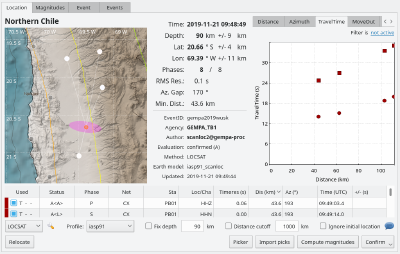scanloc
Local earthquake monitoring
Introduction

Microseismic monitoring
scanloc boosts the monitoring of natural and induced seismicity at local and regional epicentral distances. It is designed to monitor local and micro seismicity within small as well as large seismic networks. Typical networks consist of 5 to 20 stations and sometimes even many more were the station distances are in the range of hundreds of meters to tens of kilometers.
Technology
scanloc makes use of a cluster search algorithm to associate phase detections to one or many potential earthquake sources. While the cluster search itself is based on P-phases only, in a second step S-phases are also associated and used for locating the earthquake.
In order to provide high-quality picks from S phases, a new S picker is distributed along with scanloc. The S picker allows to identify S phases on the horizontal components or on the vertical components if the horizontals should be unavailable. A user-friendly GUI allows to tune the S picker configuration.
Applications

scanloc finds earthquakes from only few observations of P an S phases
scanloc has proven its performance for example by detecting between 200-300 earthquakes a day with magnitudes ranging from M1 to M4 with only very few false detections in the CX network (Chile) with station distances of about 50-70 kilometers. The module is also widely applied to record swarm earthquakes at short epicentral distances or micro earthquake in geothermal environments or in oil and gas production sites.
Employ scanloc in a wide range of monitoring:
- local and regional earthquakes
- high seismicity regions
- additional association of S phases to teleseismic earthquakes found by standard processing
- correction of fake events due to detection of teleseismic earthquakes by dense local monitoring networks
Promotion
Approved by science
scanloc has been demonstrated, promoted and discussed with scientists and the SeisComP community at international science conferences, e.g.:
A.F. Bell, P.C. La Femina, M. Ruiz, F. Amelung, M. Bagnardi, C. J. Bean, B. Bernard, C. Ebinger, M. Gleeson, J. R. Grannell, S. Hernandez, M. Higgins, C. Liorzou, P. Lundgren, N. J. Meier, M. Möllhoff, S.-J. Oliva, A. G. Ruiz and M. J. Stock: Caldera resurgence during the 2018 eruption of Sierra Negra volcano, Galápagos Islands, 2021, Nat Commun 12, 1397, DOI: https://doi.org/10.1038/s41467-021-21596-4
J. Clinton, F. Grigoli, T. Diehl, T. Kraft, L. Scarabello, M. Hermann, P. Kaestli, M. Boese, S. Wiemer: Advanced Real-time Monitoring for Natural and Induced seismic sequences, 2018, Geophyscial Research Abracts, EGU General Assembly, Vol. 20, abstract EGU2018-9480-2
F. Grigoli, M. Boese, L. Scarabello, T. Diehl, B. Weber, S. Wiemer, J. F. Clinton: Picking vs Waveform based detection and location methods for induced seismicity monitoring, 2017, Geophyscial Research Abracts, EGU General Assembly, Vol. 19, abstract EGU2018-9480-2
D. Roessler, J. Becker, E. Ellguth, R. Henneberger, S. Herrnkind, B. Weber: Cluster-search based monitoring of local earthquakes in SeisComP3, 2016, AG Seismology - 42. meeting, Bad Salzschlirf, Germany
D. Roessler, E. Ellguth, S. Herrnkind, B. Weber, R. Henneberger, H. Blanck: Cluster-search based monitoring of local earthquakes in SeisComP3, 2016, AGU Fall Meeting, San Francisco, USA, abstract S31E-06
